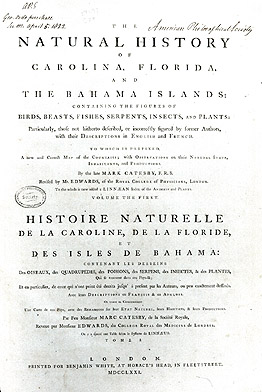 |
Polecat
(click to see associated text) |
With the continued support of Sloane and Sherard, Catesby immediately undertook a project to write up his observations. The work resulting from this second American expedition was the monumental
Natural History of Carolina, Florida, and the Bahama Islands, one of the first comprehensive surveys of the flora and fauna of the British-American colonies, and certainly the most accomplished. An elegant work issued in two volumes in 1731 and 1743, the
Natural History of Carolina is a testament to Catesby's versatility and ingenuity, and above all to his obsessive nature. Having personally conducted all of the field work and made all of the observations, Catesby assumed sole responsibility for the scientific analysis, description, and illustration. His
Natural History covers an impressive array of organisms from birds and mammals to fish, plants, reptiles, amphibians, and insects, providing both English and Indian names (when available), as well as the Latin names supplied by Sherard. Catesby was attentive, above all, to utility, remaking upon the "several mechanical and other Uses" of trees and shrubs, and commenting upon their suitability for the English climate. Far in advance of his time, he provided careful observations on habitat: the inclusion of ecological and ethological information is one of the surprising hallmarks of Catesby's science.
Catesby's major preference, it seems, was for birds, due in part, perhaps, to their abundance and diversity. Although boasting that he had missed very few species -- excepting water fowl -- he admitted that his representations were biased: "As the Males of the Feather'd Kind," he wrote, "(except a very few) are more elegantly coloured than the Females, I have throughout exhibited the Cocks only, except two or three; and have added a short description of the Hens, wherein they differ in colour from the Cocks." Whatever its limitations, Catesby's work is often regarded as the first true American ornithology, as distinct from the promotional or commercial works of predecessors like John Lawson.
 |
Dung beetle and lily
(click to see larger version) |
In many regards, it is the illustrations that most distinguish Catesby's work. Unusual for his time, Catebsy eschewed artistic interpretation for a flat, "exact" style and compensated for his lack of skill in rendering perspective for what he hoped was a naturalistic accuracy. He insisted upon drawing plants only when freshly gathered and animals while still alive, and for the birds, he attempted to depict "their Gestures peculiar to every kin. . ., and where it could be admitted. . . adapted the Birds to those Plants on which they fed, or have any relation to." With reptiles and fish, too, he was exceedingly careful, sketching when alive or, in the case of fish whose colors change after death, sketching specimens at several stages. To prepare the illustrations for publication, Catesby even learned to etch his own plates --studying with the watercolorist, Joseph Goupy -- producing 218 of the 220 plates himself and overseeing their hand coloring.
Although Catesby never earned a fortune off of his magnum opus as he hoped, he enjoyed a small, steady income until his death in 1749. The work was viewed with high esteem by his contemporaries and retained its reputation for many years, particularly in ornithological circles. Catesby was elected a Fellow of the Royal Society in 1732, and his Natural History was used as a resource by Linnaeus in sorting out the systematic relations of American birds.
The APS copy of Catesby's Natural History -- the London edition of 1771 printed by Benjamin White -- was purchased for the Society by George Ord in April, 1822, during a tour of Europe. For $150, the APS added an eclectic assortment of twenty nine works to its library, including Daniel Horsmanden's Journal of the Proceedings in the Detection of the Conspiracy Formed by Some White People in Conjunction with Negro & Other Slaves, for Burning the City of New York (New York, 1744), William Dampier's, New Voyage Round the World (London, 1699), Thomas Pennant's Arctic Zoology (London, 1792), Edward Topsell's The History of Four-Footed Beasts and Serpents (London, 1658), and Alexander Dalrymple's An Historical Collection of the Several Voyages and Discoveries in the South Pacific Ocean (London, 1770-1771).
More images
[ Lacertus viridis, the green lizard of Carolina ]
[ Flying squirrel ] [ Cedar waxwing ] [ Kingfisher ]






